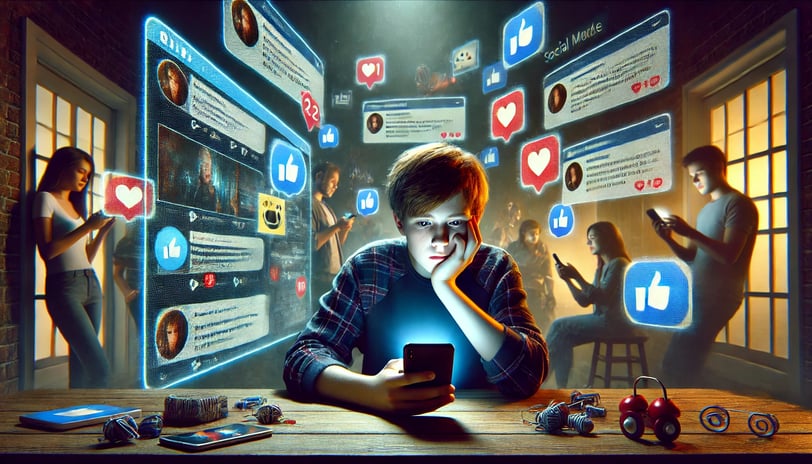The Impact of Social Media: Types, Pros and Cons, and Its Effects on Society
Social media has become an integral part of modern life in the United States, influencing how people communicate, consume information, and engage with the world. While these platforms offer numerous advantages, such as quick access to information and global connectivity, they also present challenges, including overuse, diminished social interactions, and negative impacts on education. This article explores the various types of social media, their benefits and drawbacks, and the broader implications of their widespread use.
2/19/20252 min read


Types of Social Media
Social media platforms can be categorized based on their primary functions and the type of content they facilitate.
1. Social Networking Sites
Examples: Facebook, LinkedIn, Twitter (X)
These platforms allow users to connect, share updates, and engage in discussions.
LinkedIn is more professional-oriented, while Facebook and Twitter (X) serve as hubs for social and news-related content.
2. Media-Sharing Platforms
Examples: Instagram, Snapchat, TikTok, YouTube
These focus on sharing visual content such as photos and videos.
TikTok and YouTube, in particular, have become popular for short-form and long-form video content, respectively.
3. Discussion and Community Forums
Examples: Reddit, Quora
Users engage in topic-specific discussions, ask and answer questions, and share knowledge on these platforms.
These forums provide valuable insights and expertise from various industries.
4. Messaging and Communication Apps
Examples: WhatsApp, Messenger, Discord
These are primarily used for direct communication, group messaging, and even business collaboration.
Pros of Social Media
Despite the concerns surrounding social media, there are several benefits that make it a vital part of modern society.
1. Quick Access to Information
News updates and trending topics can be accessed in real-time, allowing users to stay informed.
Educational content, tutorials, and online courses are easily available on platforms like YouTube.
2. Global Connectivity and Networking
Social media bridges the gap between people from different parts of the world, fostering global communication.
Professionals can network and find career opportunities through LinkedIn.
3. Marketing and Business Growth
Businesses leverage social media for brand visibility, targeted advertising, and customer engagement.
Influencers and content creators can monetize their presence through partnerships and ad revenue.
4. Awareness and Social Change
Social media has played a crucial role in raising awareness about important social issues, including human rights and environmental concerns.
Cons of Social Media
While social media offers numerous benefits, it also has drawbacks that can negatively impact individuals and society.
1. Overuse and Addiction
Excessive time spent on social media can lead to dependency, affecting productivity and mental health.
The constant need for validation through likes and comments can impact self-esteem.
2. Decline in Face-to-Face Interaction
People increasingly prefer digital communication over in-person interactions, reducing social skills.
Relationships can suffer due to a lack of meaningful personal connections.
3. Misinformation and Fake News
The rapid spread of false information can mislead users and create societal divisions.
Algorithms often promote sensationalized content over factual reporting.
4. Cyberbullying and Online Harassment
Many users, especially teenagers, face harassment and cyberbullying on social media platforms.
Online anonymity can encourage harmful behavior and trolling.
Impact on Education and Cognitive Abilities
The widespread use of social media has both positive and negative effects on students and learners.
1. Distraction from Studies
Constant notifications and social media scrolling can reduce focus and academic performance.
Students may struggle to manage their time effectively when engaging in excessive social media use.
2. Fast Consumption of Information
While social media provides quick access to knowledge, it often leads to surface-level understanding rather than deep learning.
The rise of short-form content (such as TikTok and Instagram Reels) encourages rapid information consumption but may lack depth.
3. Impact on Critical Thinking
Algorithms create echo chambers, reinforcing pre-existing beliefs and limiting exposure to diverse viewpoints.
Users may struggle to differentiate between credible sources and misinformation.
Conclusion
Social media is a powerful tool that has transformed communication, business, and education. However, its overuse and negative effects cannot be overlooked. While it offers benefits such as instant connectivity and access to knowledge, it also contributes to addiction, misinformation, and social disconnection. Balancing social media usage, promoting media literacy, and encouraging meaningful offline interactions are crucial steps toward harnessing its potential while mitigating its downsides. As the digital landscape continues to evolve, individuals and society must navigate social media responsibly to maximize its benefits and minimize its risks.
Explore
Discover diverse topics in one convenient hub.
Connect
Learn
contact@mindstormblog.com
© 2025. All rights reserved.

